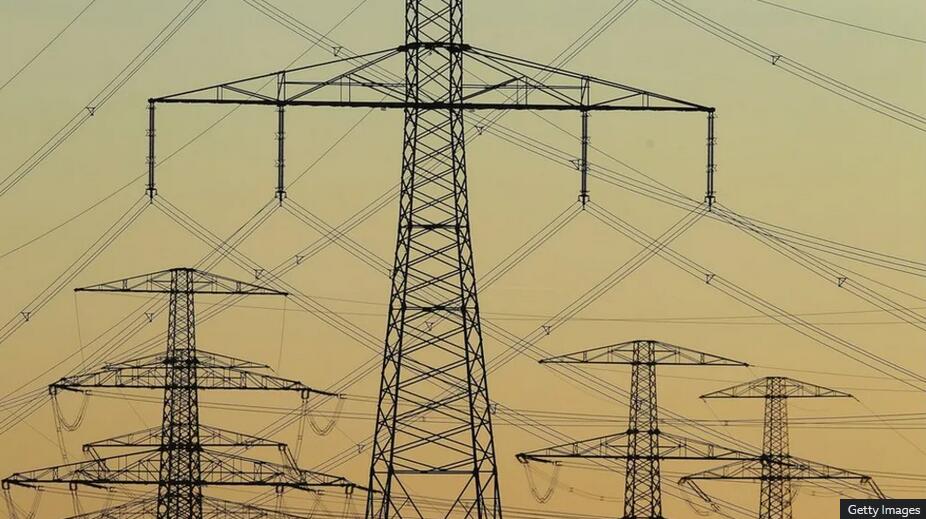The UK’s electricity network needs almost a further £60bn of upgrades to hit government decarbonisation targets by 2035, according to a new plan.
About 4,000 miles of undersea cables and 1,000 miles of onshore power lines are needed, said the National Grid’s Electricity Systems Operator (ESO).
The investment would add between £20 to £30 a year to customer bills, it said.
The government said the ESO’s plans were preliminary and yet to pass a “robust planning process”.
The plans were written up by the ESO, the organisation which runs the electricity network and would run the updated system it is calling for too. It is currently owned by National Grid but will transfer into government ownership later this year.
Its latest £58bn estimate is for work needed between 2030 and 2035 and comes on top of a previous £54bn estimate for work taking place between now and 2030.
The additional infrastructure spend would help get the UK’s offshore wind from where it is produced out at sea, to where it is used by households across the country.
That would be key in making greener energy, according to the ESO, which said the project would be the largest build of its kind for seven decades.
The government said the plans would support more than 20,000 jobs, but these are preliminary ones that would have to go through a robust planning process – a stage at which many infrastructure plans have failed.
- Discounts return to cut electricity amid cold snap
- Energy bills predicted to fall by nearly £300
The ESO says this is the kind of ambitious plan needed to deliver clean, secure, decarbonised energy. It called for “swift and co-ordinated” progress, and said that without it, the country’s climate ambitions might be at risk.
“Great Britain is about to embark upon the biggest change to the electricity network since the high voltage transmission grid was established back in the 1950s,” it said.
New connections and more grid capacity will also be needed as people and companies switch to using electricity for their cars or heating their homes. Renewable forms of generating energy, including through solar and wind farms, will also change the way the grid is shaped.
The undersea cables will have to come ashore at various points, predominantly on the east coast of Scotland and England – and from there, on to places near urban centres via overhead pylons or at four times the cost, under the ground. Hot spots for the new pylons include West Wales and a route through East Anglia.
Speaking to the BBC, Jake Rigg, corporate affairs director at the ESO, said conversation with communities across the UK is ongoing.
Critics have said the plan would deface areas of outstanding national beauty by adding more pylons – the huge steel structures which have been accused of blighting landscapes.
“What we’re trying to do is minimise impact on communities, in particular Scotland and East Anglia,” Mr Rigg said, adding that while “undergrounding” can be done to prevent erection of pylons, those processes are more expensive and require more maintenance.
Rosie Pearson lives in Kelvedon in Essex and is the founder of the campaign group Essex Suffolk Norfolk pylons. She said that opponents of the plans are not anti-wind power, but more of the network should be out at sea, and that power lines can – and should – be buried underground.

“Whenever anyone thinks about a grid upgrade, they think about pylons. No-one thinks about these other, better ways of doing things so that’s what upsets people when they’re told they’re going to have a pylon next to their garden.”
“We’re fully supportive of the need for a grid upgrade, but what’s got to happen is it’s got to be done in the best way possible and it’s got to bring communities along with it”, she told the BBC.
A spokesperson from the Department for Energy Security and Net Zero said: “Any projects taken forward would be required to progress through a robust planning process.
“To keep up with growing demand, work to reinforce the grid would connect more low-cost offshore wind and low carbon energy, helping to future proof our energy supply, reduce bills and bring the UK closer to our net zero goals”.
As well as a forecasted rise in projected electricity usage, the UK’s supply of energy was affected by Russia’s invasion of Ukraine.
It prompted the National Grid’s ESO to run a scheme allowing discounts for some households if they reduced energy usage during peak hours, as well as broader questions on the UK’s energy security.


